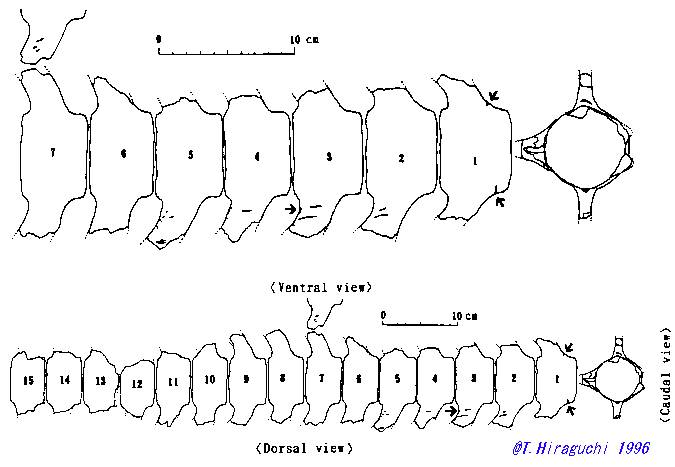Abstract
his present study discusses a custom of sharing in dolphin "fishing"
in the Jomon-period, mainly on the basis of the butchery marks in the case
of an articulated vertebrae of a dolphin, excavated from the Mawaki site.
The example is of a bottlenose dolphin size and consists of 15 vertebrae
from lumbar to caudal, probably L10 to Ca9, the total length of about 71
cm. No.9 (Ca1) has 46.6 mm length of corpus vertebrae, 60.8 mm breadth
of facies terminalis caudalis and 59.0 mm height of facies
terminalis caudalis. No.1 (Ca9) shows cut marks in the direction
of the cranial-caudal line on the caudal base of left and right processus transversi. Scratch injuries are found in the direction of the
cranial-caudal line on the dorsal surface of the left processus transversi
of No.2 (Ca8) to No.5 (Ca5) and also on the ventral surface of the right
processus transversus of No.7 (Ca3). Cut or scratch injuries are
found in the direction of the dorsal-ventral line on the cranial side of
left processus transversus. I regard the cut marks on No.1 (Ca9)
as incisions caused by dividing articulated vertebrae covered with strong
ligaments into sections, though it is a hard task, for fishermen sharing
a dolphin not only with in their own settlement but also with other settlements.
Fig.1 The cut marks on an articulated vertebrae
of dolphin bones (Bottlenose Dolphin size, '82No.1528), excavated from
the Mawaki site.
 |
Table 1 The case of an articulated vertebrae of dolphin with butchery
marks, excavated from th Mawaki site.
Reference
No. |
Presumed
Element |
Length of
Corpus (mm) |
Breadth of
Ftc (mm) |
Height of
Ftc (mm) |
| 1 |
Ca 9 |
52.5 |
58.8 |
60.6 |
| 2 |
Ca 8 |
51.3 |
59.8 |
61.0 |
| 3 |
Ca 7 |
50.2 |
60.2 |
59.3 |
| 4 |
Ca 6 |
48.2 |
60.4 |
59.5 |
| 5 |
Ca 5 |
47.7 |
60.8 |
59.0 |
| 6 |
Ca 4 |
45.7 |
62.3 |
59.8 |
| 7 |
Ca 3 |
47.0 |
61.0 |
58.6 |
| 8 |
Ca 2 |
46.8 |
61.7 |
59.2 |
| 9 |
Ca 1 |
46.6 |
60.8 |
59.0 |
| 10 |
L 15 |
45.3 |
61.8 |
57.3 |
| 11 |
L 14 |
45.4 |
62.2 |
59.3 |
| 12 |
L 13 |
45.6 |
- |
- |
| 13 |
L 12 |
45.6 |
61.3 |
55.5 |
| 14 |
L 11 |
44.6 |
62.0 |
55.0 |
| 15 |
L 10 |
45.0 |
60.0 |
54.0 |
Table 2 The butchery mark percentage of the dolphin bones of
Mawaki and the deer/wild pig bones of Torihama.
| Element |
Torihama '85L2
(Hongo, 1991) |
Mawaki �T-�]�T-grid(14m�~6m)
Dolphn |
Deer
Number(%) |
Wild pig
Number(%) |
Number(%) with butchery marks |
Total |
| crunium |
1(5.0) |
7(2.5) |
0(0) |
105(animals) |
| antler |
12(4.0) |
|
|
|
| mandible |
18(1.3) |
9(7.9) |
some examples outside the grid |
|
| atlas |
2(1.1) |
8(11.0) |
0(0) |
286(animals, including examples outside the grid) |
| cervical(3-7) |
1(1.7) |
|
|
|
| lumber |
1(1.6) |
|
|
|
| sacrum |
1(10.0) |
|
|
|
| articulated L to Ca |
|
|
4(7.1) |
56(sets) |
| scapula |
11(8.7) |
8(9.8) |
6(3.2) |
190(pieces) |
| humerus |
30(17.4) |
4(14.4) |
1(0.8) |
132(pieces) |
| radius |
18(12.0) |
3(5.7) |
0(0) |
141(pieces) |
| ulna |
5(5.7) |
6(8.3) |
0(0) |
119(pieces) |
| coxa |
1(0.9) |
1(18.3) |
|
| femur |
11(4.9) |
3(3.3) |
| tibia |
35(15.6) |
1(10.3) |
| calcaneus |
8(8.7) |
6(16.2) |
| Talus |
9(9.3) |
3(16.7) |
| matacarpus |
6(3.9) |
1(1.6) |
| metatarsus |
9(2.9) |
|
(Nihonkai Cetology, 6:15-20, 1996)
|
